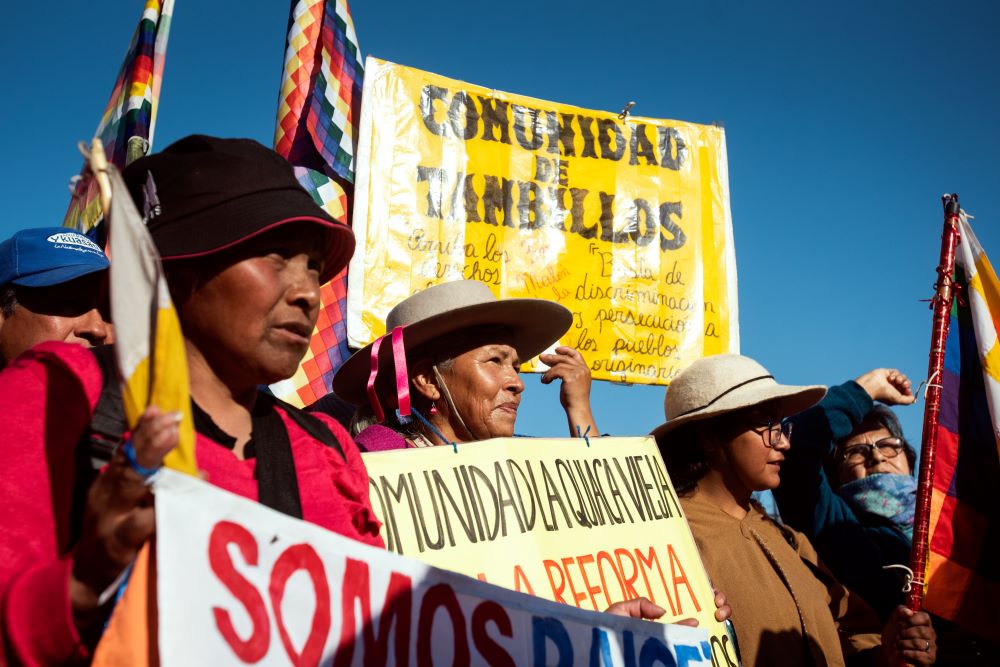Comment: A high-level panel is working to define principles for responsible mining, which will be presented to the UN General Assembly in September
Claudia Velarde is Co-director of the Ecosystems Program at the Interamerican Association for Environmental Defense (AIDA), Stephanie Weiss is a Project Coordinator at AIDA, and Jessica Solórzano is an Economic Specialist at AIDA.
The global push toward renewable energy, intended to reduce climate-aggravating emissions, has revealed how the environmental and social costs of extracting the minerals it requires fall disproportionately on local communities and ecosystems.
Many argue that electromobility and renewable energy technologies will help mitigate climate change – but adopting them on a large scale would require a massive increase in the mining of minerals such as lithium, which are key to their development.
According to the World Bank, the extraction of 3 billion tons of minerals over the next 30 years is crucial to powering the global energy transition. The International Energy Agency further predicts a four-fold increase in mineral extraction by 2040 to meet climate targets.
However, the rush for these so-called “critical” minerals risks amplifying the very crises it seeks to help solve, exacerbating ecological degradation and perpetuating socio-economic injustice in the Global South.
Q&A: What you need to know about clean energy and critical minerals supply chains
The very naming of these transition minerals as “critical” creates a false sense of urgency, reinforcing the current damaging system of extraction, and failing to consider the protection of communities, ecosystems, and species in areas of exploitation.
While mainstream strategies emphasize technological fixes, a deeper examination reveals that, without addressing the broader implications of mineral extraction, the quest for a greener future may only deepen existing environmental and human rights violations.
UN-backed principles
The UN Secretary-General’s Panel on Critical Energy Transition Minerals was formed in April this year to identify common and voluntary principles that will help developing countries benefit from equitable, fair and sustainable management of these minerals.
The Panel brings together strange bedfellows – not least China and the US – and will need to work hard to create consensus to identify principles and recommendations for governments, companies, investors and the international community on human rights, environmental protection, justice and equity in value chains, benefit-sharing, responsible investments, transparency and international collaboration. It must raise the level of ambition and listen directly to civil society organizations and rights-holders, including local communities.
Our reflection on what the Panel cannot ignore points to three elements: a status quo approach to “development”; a high level of technological optimism concerning mining; and a lack of urgency regarding ecosystem limits and communities’ rights.
Indonesia turns traditional Indigenous land into nickel industrial zone
First, we acknowledge that the Panel is under pressure from powerful actors, but it will need to resist the assertion that mining is always beneficial to the economic growth and prosperity of nations. This status-quo perspective reinforces the notion of unlimited natural resources for human consumption, mirroring the economic development promises of the early 20th century, which contributed to the current climate crisis.
The Panel must not fail to consider the possibility of degrowth or the imposition of limits on mining activities that could lead to reduced material and energy consumption. Nor should it neglect other forms of traditional and local knowledge that may offer possibilities for alternative development.
Then, on the impacts, pollution and other ecosystem disruptions caused by mining, it is consistently stated that assessments and evaluations are necessary – and that these can preserve ecosystem integrity.
The Panel must acknowledge the irreversibility of certain mining impacts on ecosystems, which are already evident. This belies the optimistic view that all mining problems can be resolved through technology, a notion that is both false and unrealistic. What’s more, it undermines the precautionary principle, which calls for protective action from suspected harms, even before scientific proof exists.
Finally, in the dominant narrative, transition minerals are found in “empty” places, deemed void of life, where only the resources to be extracted are counted. This ignores both the biodiversity and traditional communities that inhabit these areas.
Indigenous rights at risk
More than half of the minerals needed for the energy transition are found in or near indigenous territories, which are already facing the consequences of the climate and ecological crisis, such as extreme aridity, permanent water shortages and scarce water availability.
These impacts may be increased by mining project pressures and mineral extractive activities, which are already facing the impacts of the climate and ecological crisis, such as extreme aridity, permanent water shortages or scarce water availability.
It is essential to ensure respect for the right of indigenous peoples to self-determination; to obtain their free, prior and informed consent (FPIC) before projects are begun; to carry out human rights and environmental due diligence; and to ensure not only remediation of impacts but also the ability of local people to maintain their own cultural, social, economic and political ways.
Lithium tug of war: the US-China rivalry for Argentina’s white gold
In addition, current plans for the extraction of transition minerals are limited to the scale of the mining concession in question, without considering the cumulative impacts derived from others operating in the same area and ignoring the socioeconomic activities already taking place in these ecosystems.
Instead, it is essential to ensure the bio-capacity of ecosystems to maintain their life-supporting functions and the diversity of uses by communities in territories, not just industrial ones. Decisions on mineral extraction should not be based solely on market demand, but also on the biophysical limits of ecosystems and, more sensibly,
Read More

